Wacton.Unicolour
4.8.0
dotnet add package Wacton.Unicolour --version 4.8.0
NuGet\Install-Package Wacton.Unicolour -Version 4.8.0
<PackageReference Include="Wacton.Unicolour" Version="4.8.0" />
paket add Wacton.Unicolour --version 4.8.0
#r "nuget: Wacton.Unicolour, 4.8.0"
// Install Wacton.Unicolour as a Cake Addin #addin nuget:?package=Wacton.Unicolour&version=4.8.0 // Install Wacton.Unicolour as a Cake Tool #tool nuget:?package=Wacton.Unicolour&version=4.8.0
Unicolour
Unicolour is the most comprehensive .NET library for working with colour:
- Colour space conversion
- Colour mixing / colour interpolation
- Colour difference / colour distance
- Colour gamut mapping
- Colour chromaticity
- Colour temperature
- Wavelength attributes
- ICC profiles for CMYK conversion
Written in C# with zero dependencies and supports full cross-platform compatibility.
Targets .NET Standard 2.0 for use in .NET 5.0+, .NET Core 2.0+ and .NET Framework 4.6.1+ applications.
See a live demo in the browser — a colour picker for any colour space — made with Unicolour.
Contents
- 🧭 Overview
- 🔆 Installation
- ⚡ Quickstart
- 🌈 Features
- 💡 Configuration
- ✨ Examples
- 🔮 Datasets
🧭 Overview
A Unicolour encapsulates a single colour and its representation across 30+ colour spaces.
It can be used to mix and compare colours, as well as other useful tools for working with colour.
Supported colour spaces
RGB · Linear RGB · HSB / HSV · HSL · HWB · HSI · CIEXYZ · CIExyY · WXY · CIELAB · CIELChab · CIELUV · CIELChuv · HSLuv · HPLuv · YPbPr · YCbCr / YUV (digital) · YCgCo · YUV (PAL) · YIQ (NTSC) · YDbDr (SECAM) · TSL · XYB · IPT · ICTCP · Jzazbz · JzCzhz · Oklab · Oklch · Okhsv · Okhsl · Okhwb · CIECAM02 · CAM16 · HCT · CMYK ?
Unicolour pink = new("#FF1493"); Console.WriteLine(pink.Oklab); // 0.65 +0.26 -0.01
This library was initially written for personal projects since existing libraries had complex APIs, missing features, or inaccurate conversions. The goal of this library is to be accurate, intuitive, and easy to use. Although performance is not a priority, conversions are only calculated once; when first evaluated (either on access or as part of an intermediate conversion step) the result is stored for future use.
Unicolour is extensively tested, including verification of roundtrip conversions, validation using known colour values, and 100% line coverage and branch coverage.
🔆 Installation
- Install the package from NuGet
dotnet add package Wacton.Unicolour
- Import the package
using Wacton.Unicolour;
- Use the package
Unicolour colour = new(ColourSpace.Rgb255, 192, 255, 238);
⚡ Quickstart
The simplest way to get started is to make a Unicolour and use it to see how the colour is represented in a different colour space.
var cyan = new Unicolour("#00FFFF");
Console.WriteLine(cyan.Hsl); // 180.0° 100.0% 50.0%
var yellow = new Unicolour(ColourSpace.Rgb255, 255, 255, 0);
Console.WriteLine(yellow.Hex); // #FFFF00
Colours can be mixed or interpolated using any colour space.
var red = new Unicolour(ColourSpace.Rgb, 1.0, 0.0, 0.0);
var blue = new Unicolour(ColourSpace.Hsb, 240, 1.0, 1.0);
/* RGB: [1, 0, 0] ⟶ [0, 0, 1] = [0.5, 0, 0.5] */
var purple = red.Mix(blue, ColourSpace.Rgb);
Console.WriteLine(purple.Rgb); // 0.50 0.00 0.50
Console.WriteLine(purple.Hex); // #800080
/* HSL: [0, 1, 0.5] ⟶ [240, 1, 0.5] = [300, 1, 0.5] */
var magenta = red.Mix(blue, ColourSpace.Hsl);
Console.WriteLine(magenta.Rgb); // 1.00 0.00 1.00
Console.WriteLine(magenta.Hex); // #FF00FF
The difference or distance between colours can be calculated using any delta E metric.
var white = new Unicolour(ColourSpace.Oklab, 1.0, 0.0, 0.0);
var black = new Unicolour(ColourSpace.Oklab, 0.0, 0.0, 0.0);
var difference = white.Difference(black, DeltaE.Ciede2000);
Console.WriteLine(difference); // 100.0000
Other useful colour information is available, such as chromaticity coordinates, temperature, and dominant wavelength.
var equalTristimulus = new Unicolour(ColourSpace.Xyz, 0.5, 0.5, 0.5);
Console.WriteLine(equalTristimulus.Chromaticity.Xy); // (0.3333, 0.3333)
Console.WriteLine(equalTristimulus.Chromaticity.Uv); // (0.2105, 0.3158)
Console.WriteLine(equalTristimulus.Temperature); // 5455.5 K (Δuv -0.00442)
Console.WriteLine(equalTristimulus.DominantWavelength); // 596.1
Reference white points (e.g. D65) and the RGB model (e.g. sRGB) can be configured.
🌈 Features
Convert between colour spaces
Unicolour calculates all transformations required to convert from one colour space to any other, so there is no need to manually chain multiple functions and removes the risk of rounding errors.
Unicolour colour = new(ColourSpace.Rgb255, 192, 255, 238);
var (l, c, h) = colour.Oklch.Triplet;
| Colour space | Enum | Property |
|---|---|---|
| RGB (0–255) | ColourSpace.Rgb255 |
.Rgb.Byte255 |
| RGB | ColourSpace.Rgb |
.Rgb |
| Linear RGB | ColourSpace.RgbLinear |
.RgbLinear |
| HSB / HSV | ColourSpace.Hsb |
.Hsb |
| HSL | ColourSpace.Hsl |
.Hsl |
| HWB | ColourSpace.Hwb |
.Hwb |
| HSI | ColourSpace.Hsi |
.Hsi |
| CIEXYZ | ColourSpace.Xyz |
.Xyz |
| CIExyY | ColourSpace.Xyy |
.Xyy |
| WXY | ColourSpace.Wxy |
.Wxy |
| CIELAB | ColourSpace.Lab |
.Lab |
| CIELChab | ColourSpace.Lchab |
.Lchab |
| CIELUV | ColourSpace.Luv |
.Luv |
| CIELChuv | ColourSpace.Lchuv |
.Lchuv |
| HSLuv | ColourSpace.Hsluv |
.Hsluv |
| HPLuv | ColourSpace.Hpluv |
.Hpluv |
| YPbPr | ColourSpace.Ypbpr |
.Ypbpr |
| YCbCr / YUV (digital) | ColourSpace.Ycbcr |
.Ycbcr |
| YCgCo | ColourSpace.Ycgco |
.Ycgco |
| YUV (PAL) | ColourSpace.Yuv |
.Yuv |
| YIQ (NTSC) | ColourSpace.Yiq |
.Yiq |
| YDbDr (SECAM) | ColourSpace.Ydbdr |
.Ydbdr |
| TSL | ColourSpace.Tsl |
.Tsl |
| XYB | ColourSpace.Xyb |
.Xyb |
| IPT | ColourSpace.Ipt |
.Ipt |
| ICTCP | ColourSpace.Ictcp |
.Ictcp |
| Jzazbz | ColourSpace.Jzazbz |
.Jzazbz |
| JzCzhz | ColourSpace.Jzczhz |
.Jzczhz |
| Oklab | ColourSpace.Oklab |
.Oklab |
| Oklch | ColourSpace.Oklch |
.Oklch |
| Okhsv | ColourSpace.Okhsv |
.Okhsv |
| Okhsl | ColourSpace.Okhsl |
.Okhsl |
| Okhwb | ColourSpace.Okhwb |
.Okhwb |
| CIECAM02 | ColourSpace.Cam02 |
.Cam02 |
| CAM16 | ColourSpace.Cam16 |
.Cam16 |
| HCT | ColourSpace.Hct |
.Hct |
| CMYK ? | - | .Icc |
Mix colours
Two colours can be mixed by interpolating between them in any colour space, taking into account cyclic hue, interpolation distance, and alpha premultiplication.
var red = new Unicolour(ColourSpace.Rgb, 1.0, 0.0, 0.0);
var blue = new Unicolour(ColourSpace.Hsb, 240, 1.0, 1.0);
var magenta = red.Mix(blue, ColourSpace.Hsl, 0.5, HueSpan.Decreasing);
var green = red.Mix(blue, ColourSpace.Hsl, 0.5, HueSpan.Increasing);
| Hue span | Enum |
|---|---|
| Shorter 👈 default | HueSpan.Shorter |
| Longer | HueSpan.Longer |
| Increasing | HueSpan.Increasing |
| Decreasing | HueSpan.Decreasing |
Compare colours
Two methods of comparing colours are available: contrast and difference. Difference is calculated according to a specific delta E (ΔE) metric.
var red = new Unicolour(ColourSpace.Rgb, 1.0, 0.0, 0.0);
var blue = new Unicolour(ColourSpace.Hsb, 240, 1.0, 1.0);
var contrast = red.Contrast(blue);
var difference = red.Difference(blue, DeltaE.Cie76);
| Delta E | Enum |
|---|---|
| ΔE76 (CIE76) | DeltaE.Cie76 |
| ΔE94 (CIE94) graphic arts | DeltaE.Cie94 |
| ΔE94 (CIE94) textiles | DeltaE.Cie94Textiles |
| ΔE00 (CIEDE2000) | DeltaE.Ciede2000 |
| ΔECMC (CMC l:c) 2:1 acceptability | DeltaE.CmcAcceptability |
| ΔECMC (CMC l:c) 1:1 perceptibility | DeltaE.CmcPerceptibility |
| ΔEITP | DeltaE.Itp |
| ΔEz | DeltaE.Z |
| ΔEHyAB | DeltaE.Hyab |
| ΔEOK | DeltaE.Ok |
| ΔECAM02 | DeltaE.Cam02 |
| ΔECAM16 | DeltaE.Cam16 |
Map colour into display gamut
Colours that cannot be displayed with the configured RGB model can be mapped to the closest in-gamut colour. The gamut mapping algorithm conforms to CSS specifications.
var outOfGamut = new Unicolour(ColourSpace.Rgb, -0.51, 1.02, -0.31);
var inGamut = outOfGamut.MapToGamut();
Convert between colour and temperature
Correlated colour temperature (CCT) and delta UV (∆uv) can be obtained from a colour, and can be used to create a colour. CCT from 500 K to 1,000,000,000 K is supported but only CCT from 1,000 K to 20,000 K is guaranteed to have high accuracy.
var chromaticity = new Chromaticity(0.3457, 0.3585);
var d50 = new Unicolour(chromaticity);
var (cct, duv) = d50.Temperature;
var temperature = new Temperature(6504, 0.0032);
var d65 = new Unicolour(temperature);
var (x, y) = d65.Chromaticity;
Create colour from spectral power distribution
A spectral power distribution (SPD) can be used to create a colour. Wavelengths should be provided in either 1 nm or 5 nm intervals, and omitted wavelengths are assumed to have zero spectral power.
var spd = new Spd
{
{ 575, 0.5 },
{ 580, 1.0 },
{ 585, 0.5 }
};
var intenseYellow = new Unicolour(spd);
Get wavelength attributes
The dominant wavelength and excitation purity of a colour can be derived using the spectral locus. Wavelengths from 360 nm to 700 nm are supported.
var chromaticity = new Chromaticity(0.1, 0.8);
var hyperGreen = new Unicolour(chromaticity);
var dominantWavelength = hyperGreen.DominantWavelength;
var excitationPurity = hyperGreen.ExcitationPurity;
Detect imaginary colours
Whether a colour is imaginary — one that cannot be produced by the eye — can be determined using the spectral locus. They are the colours that lie outside the horseshoe-shaped curve of the CIE xy chromaticity diagram.
var chromaticity = new Chromaticity(0.05, 0.05);
var impossibleBlue = new Unicolour(chromaticity);
var isImaginary = impossibleBlue.IsImaginary;
Simulate colour vision deficiency
A new Unicolour can be generated that simulates how a colour appears to someone with a particular colour vision deficiency (CVD) or colour blindness.
var colour = new Unicolour(ColourSpace.Rgb255, 192, 255, 238);
var noRed = colour.SimulateProtanopia();
| Colour vision deficiency | Method |
|---|---|
| Protanopia (no red perception) | SimulateProtanopia() |
| Deuteranopia (no green perception) | SimulateDeuteranopia() |
| Tritanopia (no blue perception) | SimulateTritanopia() |
| Achromatopsia (no colour perception) | SimulateAchromatopsia() |
Use ICC profiles for CMYK conversion
Device-dependent colour prints of 4 (e.g. FOGRA39 CMYK) or more (e.g. FOGRA55 CMYKOGV) are supported through ICC profiles. If no ICC profile is provided, or if the profile is incompatible, naive conversion for uncalibrated CMYK is used instead.
using Wacton.Unicolour.Icc;
var fogra39 = new IccConfiguration("./Fogra39.icc", Intent.RelativeColorimetric);
var config = new Configuration(iccConfiguration: fogra39);
var navyRgb = new Unicolour(config, ColourSpace.Rgb255, 0, 0, 128);
Console.WriteLine(navyRgb.Icc); // 1.0000 0.8977 0.0001 0.2867 CMYK
var navyCmyk = new Unicolour(config, new Channels(1.0, 1.0, 0.0, 0.5));
Console.WriteLine(navyCmyk.Rgb.Byte255); // 46 37 87
The following tables summarise which ICC profiles are compatible with Unicolour:
| Profile version | |
|---|---|
| ✅ | 2 |
| ✅ | 4 |
| ❌ | 5 / iccMAX |
| Profile/device class | |
|---|---|
| ✅ | Input scnr |
| ✅ | Display mntr |
| ✅ | Output prtr |
| ✅ | ColorSpace spac |
| ❌ | DeviceLink link |
| ❌ | Abstract abst |
| ❌ | NamedColor nmcl |
| Transform | |
|---|---|
| ✅ | AToB / BToA A2B0 A2B1 A2B2 B2A0 B2A1 B2A2 |
| ✅ | TRC matrix rTRC gTRC bTRC rXYZ gXYZ bXYZ |
| ✅ | TRC grey kTRC |
| ❌ | DToB / BToD D2B0 D2B1 D2B2 D2B3 B2D0 B2D1 B2D2 B2D3 |
A wider variety of ICC profiles will be supported in future releases. If a problem is encountered using an ICC profile that meets the above criteria, please raise an issue.
Handle invalid values
It is possible for invalid or unreasonable values to be used in calculations, either because conversion formulas have limitations or because a user passes them as arguments. Although these values don't make sense to use, they should propagate safely and avoid triggering exceptions.
var bad1 = new Unicolour(ColourSpace.Oklab, double.NegativeInfinity, double.NaN, double.Epsilon);
var bad2 = new Unicolour(ColourSpace.Cam16, double.NaN, double.MaxValue, double.MinValue);
var bad3 = bad1.Mix(bad2, ColourSpace.Hct, amount: double.PositiveInfinity);
Sensible defaults, highly configurable
Unicolour uses sRGB as the default RGB model and standard illuminant D65 (2° observer) as the default white point of all colour spaces,
ensuring consistency and a suitable starting point for simple applications.
These can be overridden using the Configuration parameter, and common configurations have been predefined.
var defaultConfig = new Configuration(RgbConfiguration.StandardRgb, XyzConfiguration.D65);
var colour = new Unicolour(defaultConfig, ColourSpace.Rgb255, 192, 255, 238);
Zero dependencies, quality controlled
Each line of artisan code is exquisitely handcrafted in small-batch programming sessions. No dependencies are used, so there is no risk of reliance on deprecated, obsolete, or unmaintained packages. Every line of code is tested, and any defect is Unicolour's responsibility.
💡 Configuration
The Configuration parameter can be used to customise how colour is processed.
Example configuration with predefined Rec. 2020 RGB & illuminant D50 (2° observer) XYZ:
Configuration config = new(RgbConfiguration.Rec2020, XyzConfiguration.D50);
Unicolour colour = new(config, ColourSpace.Rgb255, 204, 64, 132);
Example configuration with manually defined wide-gamut RGB & illuminant C (10° observer) XYZ:
var rgbConfig = new RgbConfiguration(
chromaticityR: new(0.7347, 0.2653),
chromaticityG: new(0.1152, 0.8264),
chromaticityB: new(0.1566, 0.0177),
whitePoint: Illuminant.D50.GetWhitePoint(Observer.Degree2),
fromLinear: value => Math.Pow(value, 1 / 2.19921875),
toLinear: value => Math.Pow(value, 2.19921875)
);
var xyzConfig = new XyzConfiguration(Illuminant.C, Observer.Degree10);
var config = new Configuration(rgbConfig, xyzConfig);
var colour = new Unicolour(config, ColourSpace.Rgb255, 202, 97, 143);
A Configuration is composed of sub-configurations.
Each sub-configuration is optional and will fall back to a sensible default if not provided.
RgbConfiguration
Defines the RGB model, often used to specify a wider gamut than standard RGB (sRGB).
| Predefined | Property |
|---|---|
| sRGB 👈 default | .StandardRgb |
| Display P3 | .DisplayP3 |
| Rec. 2020 | .Rec2020 |
| A98 | .A98 |
| ProPhoto | .ProPhoto |
| ACES 2065-1 | .Aces20651 |
| ACEScg | .Acescg |
| ACEScct | .Acescct |
| ACEScc | .Acescc |
| Rec. 601 (625-line) | .Rec601Line625 |
| Rec. 601 (525-line) | .Rec601Line525 |
| Rec. 709 | .Rec709 |
| xvYCC | .XvYcc |
| PAL (Rec. 470) | .Pal |
| PAL-M (Rec. 470) | .PalM |
| PAL 625 (Rec. 1700) | .Pal625 |
| PAL 525 (Rec. 1700) | .Pal525 |
| NTSC (Rec. 470) | .Ntsc |
| NTSC (SMPTE-C) | .NtscSmpteC |
| NTSC 525 (Rec. 1700) | .Ntsc525 |
| SECAM (Rec. 470) | .Secam |
| SECAM 625 (Rec. 1700) | .Secam625 |
- Parameters
- Red, green, and blue chromaticity coordinates
- Reference white point
- Companding functions to and from linear values
XyzConfiguration
Defines the XYZ white point (which is also inherited by colour spaces that do not need a specific configuration), as well as the observer to use for temperature calculations.
| Predefined | Property |
|---|---|
| D65 (2° observer) 👈 default | .D65 |
| D50 (2° observer) | .D50 |
- Parameters
- Reference white point or illuminant
- Observer
YbrConfiguration
Defines the constants, scaling, and offsets required to convert to YPbPr and YCbCr.
| Predefined | Property |
|---|---|
| Rec. 601 👈 default | .Rec601 |
| Rec. 709 | .Rec709 |
| Rec. 2020 | .Rec2020 |
| JPEG | .Jpeg |
- Parameters
- Luma constants for component video separation
- Mapping ranges for digital encoding
CamConfiguration
Defines the viewing conditions for CAM02 and CAM16, which take into account the surrounding environment to determine how a colour is perceived.
| Predefined | Property |
|---|---|
| sRGB 👈 default | .StandardRgb |
| HCT | .Hct |
The predefined sRGB configuration refers to an ambient illumination of 64 lux under a grey world assumption.
- Parameters
- Reference white point
- Adapting luminance
- Background luminance
IccConfiguration
Defines the ICC profile and rendering intent, typically used for accurate CMYK conversion.
| Predefined | Property |
|---|---|
| None 👈 default | .None |
Unicolour does not embed or distribute ICC profiles. Some commonly used profiles can be found in the ICC profile registry.
- Parameters
- ICC profile (
.iccfile) - Rendering intent
- ICC profile (
IctcpScalar & JzazbzScalar
There is ambiguity and no clear consensus about how XYZ values should be scaled before calculating ICTCP and Jzazbz. These scalars can be changed to match the behaviour of other implementations if needed.
White points
All colour spaces are impacted by the reference white point. Unicolour applies different reference white points to different sets of colour spaces, as shown in the table below. When a conversion to or from XYZ space involves a change in white point, a chromatic adaptation transform (CAT) is performed using the Bradford method.
| White point configuration | Affected colour spaces |
|---|---|
RgbConfiguration |
RGB · Linear RGB · HSB / HSV · HSL · HWB · HSI · YPbPr · YCbCr / YUV (digital) · YCgCo · YUV (PAL) · YIQ (NTSC) · YDbDr (SECAM) · TSL · XYB |
XyzConfiguration |
CIEXYZ · CIExyY · WXY · CIELAB · CIELChab · CIELUV · CIELChuv · HSLuv · HPLuv |
CamConfiguration |
CIECAM02 · CAM16 |
| None (always D65/2°) | IPT · ICTCP · Jzazbz · JzCzhz · Okhsv · Okhsl · Okhwb · HCT |
Convert between configurations
A Unicolour can be converted to a different configuration,
in turn enabling conversions between different RGB models, XYZ white points, CAM viewing conditions, ICC profiles, etc.
/* pure sRGB green */
var srgbConfig = new Configuration(RgbConfiguration.StandardRgb);
var srgbColour = new Unicolour(srgbConfig, ColourSpace.Rgb, 0, 1, 0);
Console.WriteLine(srgbColour.Rgb); // 0.00 1.00 0.00
/* ⟶ Display P3 */
var displayP3Config = new Configuration(RgbConfiguration.DisplayP3);
var displayP3Colour = srgbColour.ConvertToConfiguration(displayP3Config);
Console.WriteLine(displayP3Colour.Rgb); // 0.46 0.99 0.30
/* ⟶ Rec. 2020 */
var rec2020Config = new Configuration(RgbConfiguration.Rec2020);
var rec2020Colour = displayP3Colour.ConvertToConfiguration(rec2020Config);
Console.WriteLine(rec2020Colour.Rgb); // 0.57 0.96 0.27
✨ Examples
This repository contains projects showing how Unicolour can be used to create:
- Gradient images
- Heatmaps of luminance
- Diagrams of colour data
- A colourful console application
- A colour picker web application
- 3D visualisations of colour spaces in Unity
Gradients
Example code to create gradient images using 📷 SixLabors.ImageSharp can be seen in the Example.Gradients project.
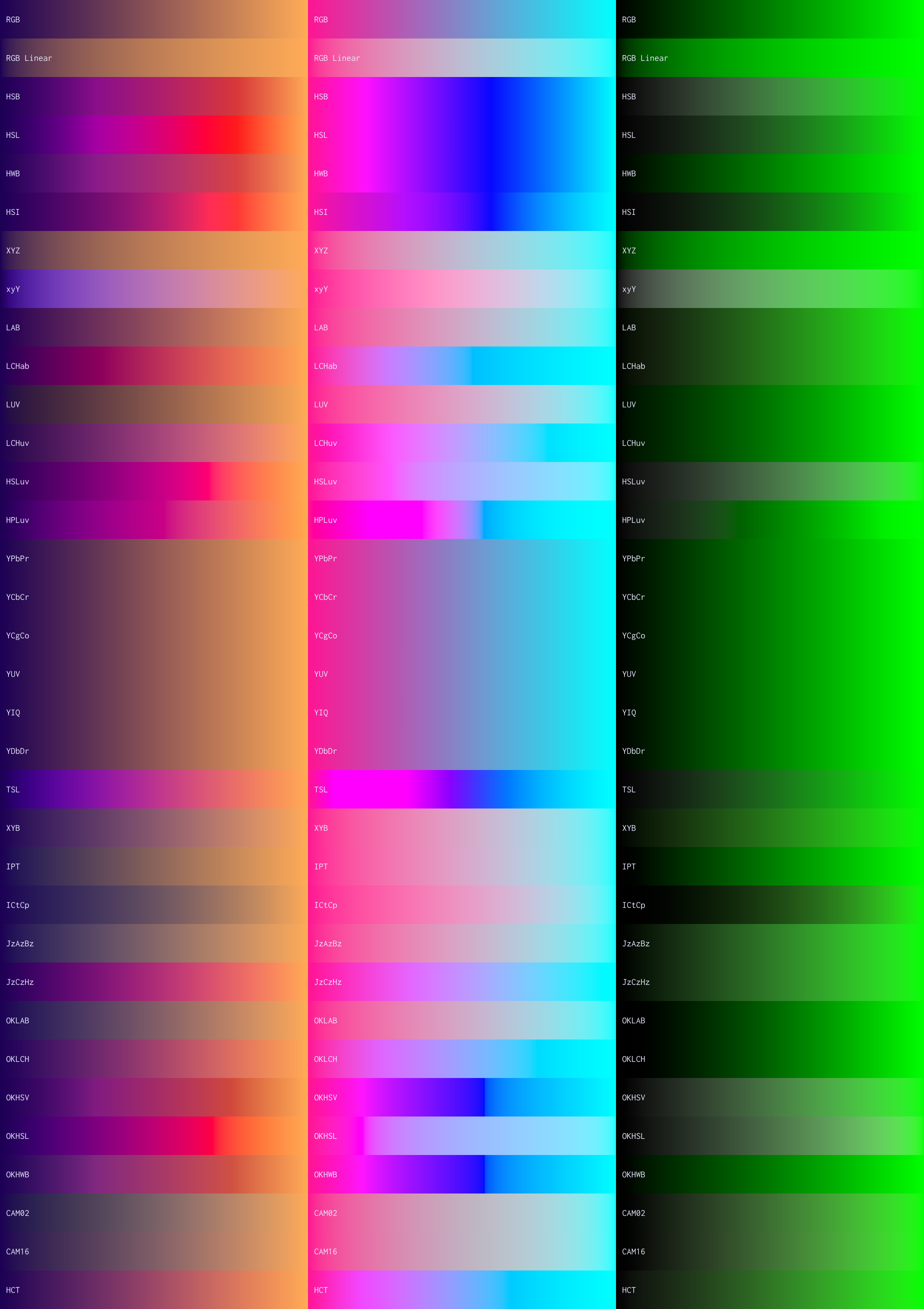 |
|---|
| Gradients generated through each colour space |
 |
|---|
| Visualisation of temperature from 1,000 K to 13,000 K |
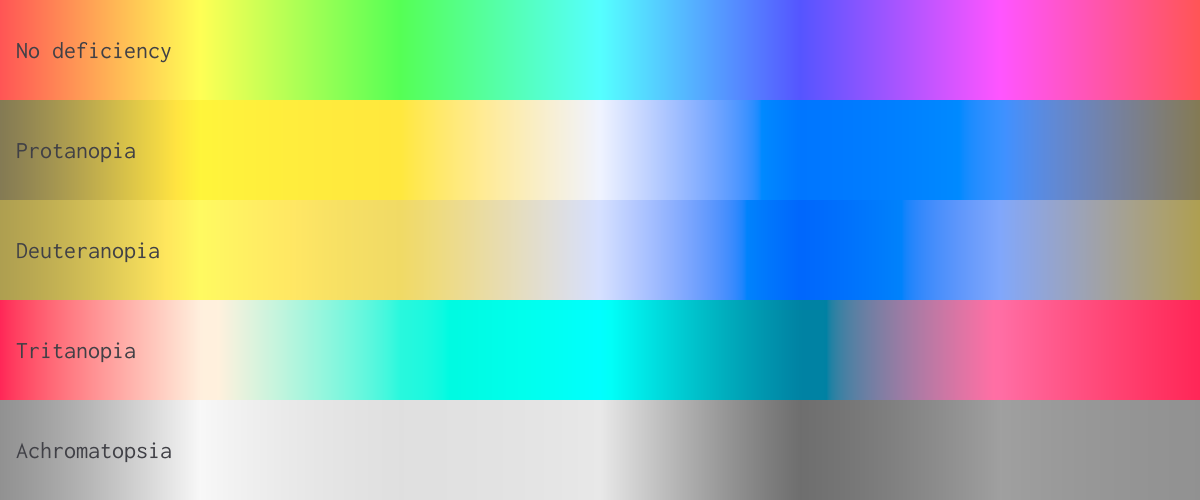 |
|---|
| Colour spectrum rendered with different colour vision deficiencies |
 |
|---|
| Demonstration of interpolating from red to transparent to blue, with and without premultiplied alpha |
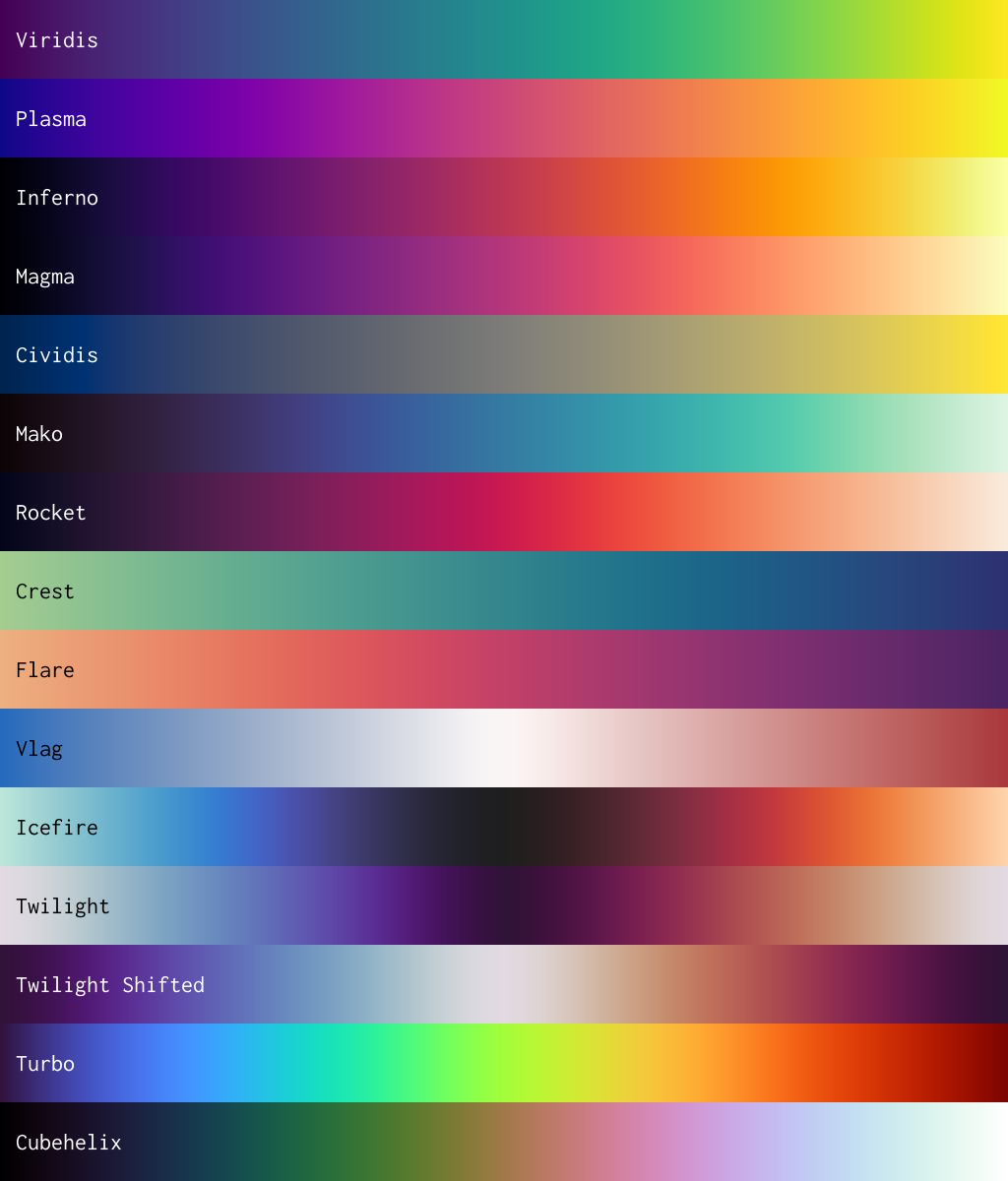 |
|---|
| Perceptually uniform colourmaps from Unicolour.Datasets |
Heatmaps
Example code to create heatmaps of luminance using 📷 SixLabors.ImageSharp with images from 🚀 NASA can be seen in the Example.Heatmaps project.
 |
|---|
| Heatmap of the ☀️ sun using perceptually uniform colourmaps from Unicolour.Datasets |
 |
|---|
| Heatmap of the 🌕 moon using perceptually uniform colourmaps from Unicolour.Datasets |
Diagrams
Example code to create diagrams of colour data using 📈 ScottPlot can be seen in the Example.Diagrams project.
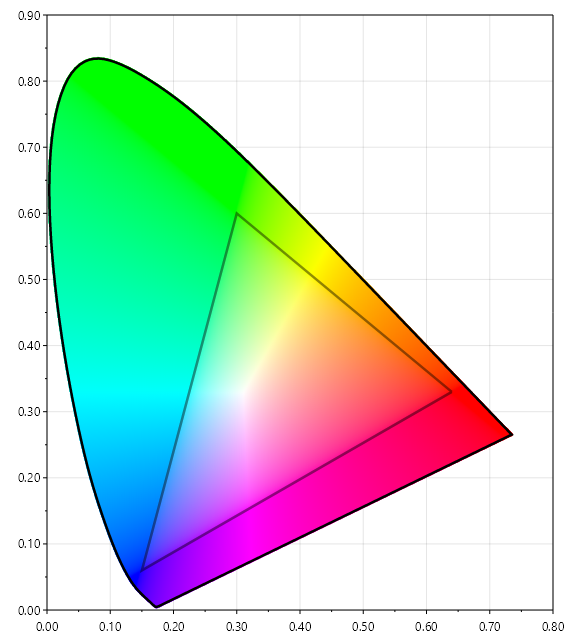 |
|---|
| CIE xy chromaticity diagram with sRGB gamut |
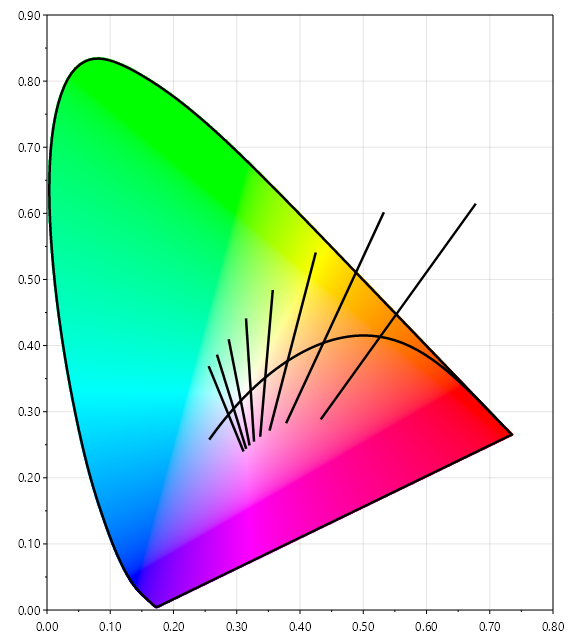 |
|---|
| CIE xy chromaticity diagram with Planckian or blackbody locus |
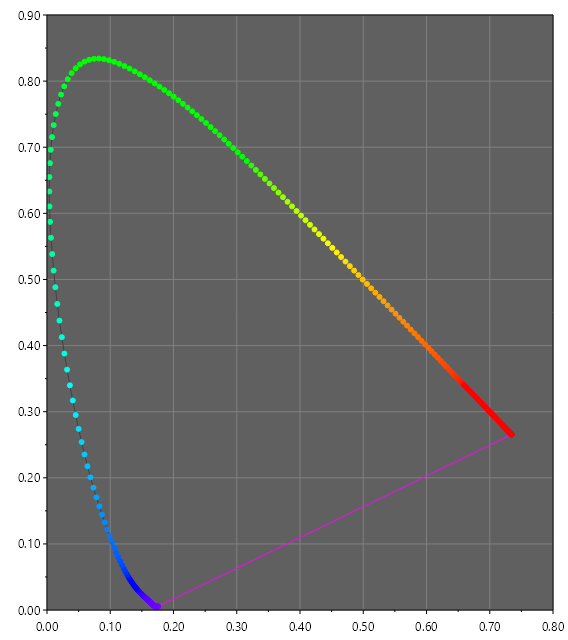 |
|---|
| CIE xy chromaticity diagram with spectral locus plotted at 1 nm intervals |
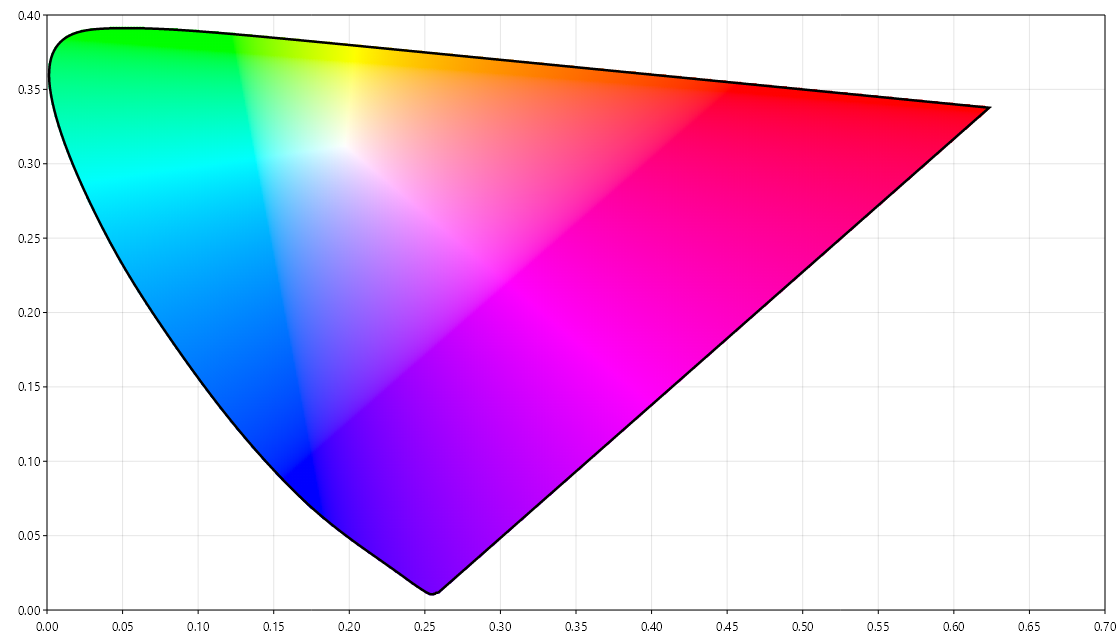 |
|---|
| CIE 1960 colour space |
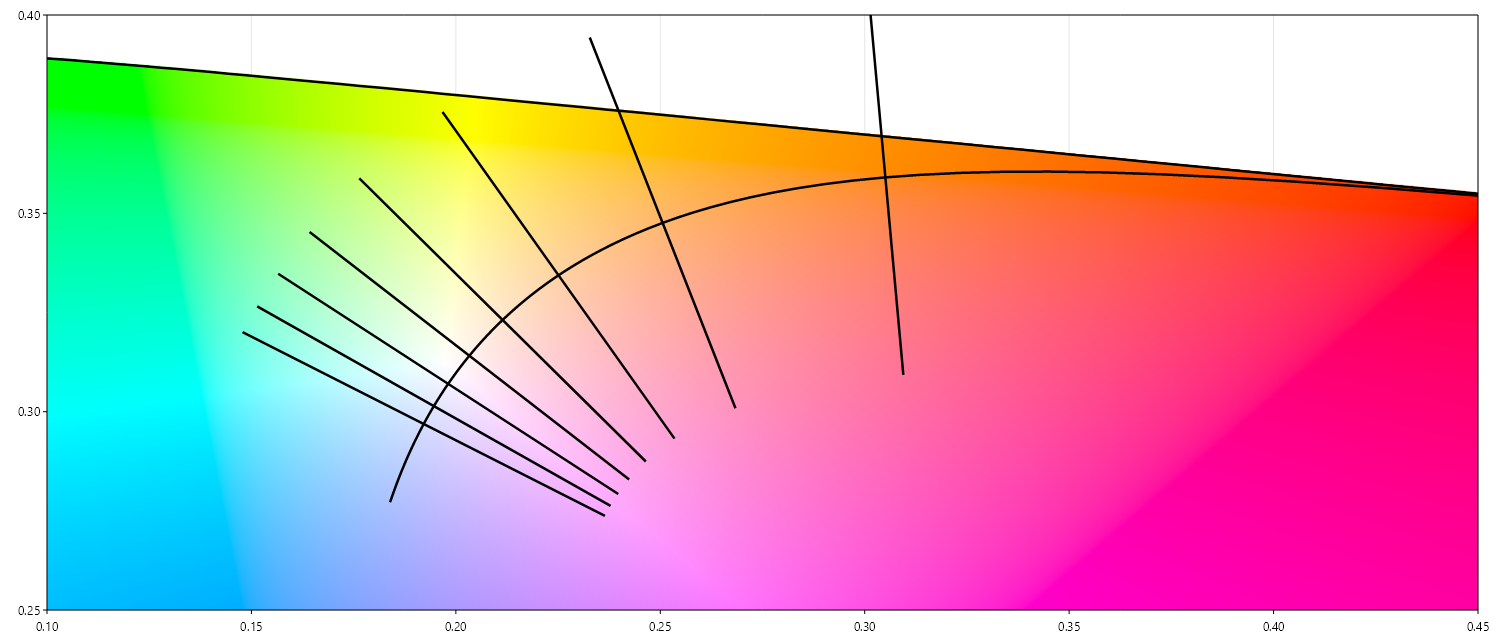 |
|---|
| CIE 1960 colour space with Planckian or blackbody locus |
Console
Example code to create a colourful console application using ⌨️ Spectre.Console can be seen in the Example.Console project.
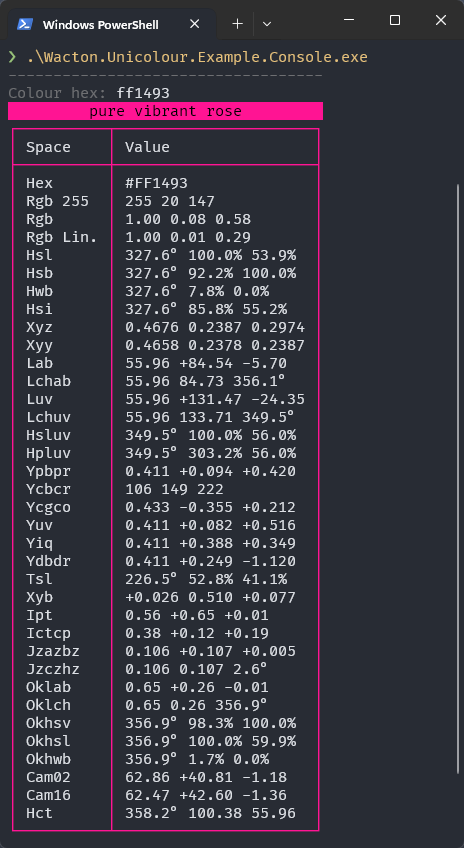 |
|---|
| Console application displaying colour information from a hex value |
Web
Example code to create a client-side colour picker web application using 🕸️ Blazor can be seen in the Example.Web project.
See the live demo!
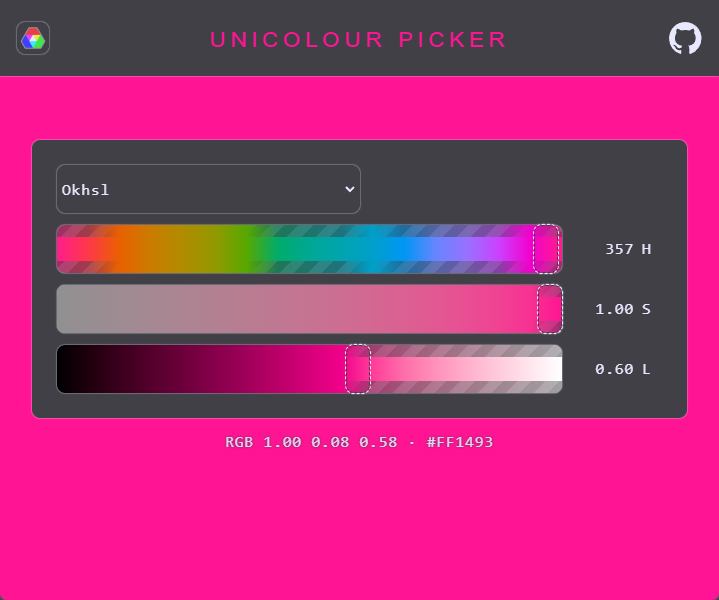 |
|---|
| Web application for picking colours in any colour space |
Unity
Example code to create 3D visualisations of colour spaces using 🎮 Unity can be seen in the Example.Unity project.
Try it out online in Unity Play!
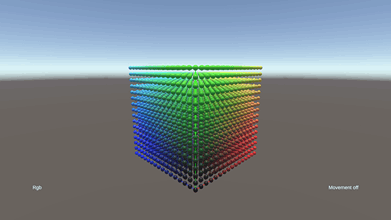 |
|---|
| 3D visualisation of colour spaces in Unity |
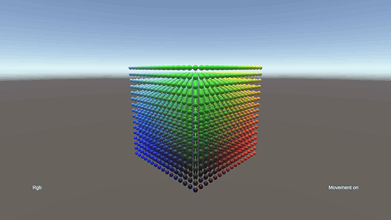 |
|---|
| 3D movement through colour spaces in Unity |
🔮 Datasets
Some colour datasets have been compiled for convenience and are available as a NuGet package.
Commonly used sets of colours:
- CSS specification named colours
- xkcd colour survey results
- Macbeth ColorChecker colour rendition chart
- Nord theme colours
Perceptually uniform colourmaps / palettes:
- Viridis, Plasma, Inferno & Magma (sequential)
- Cividis (sequential)
- Mako, Rocket, Crest & Flare (sequential)
- Vlag & Icefire (diverging)
- Twilight & Twilight Shifted (cyclic)
- Turbo (rainbow)
- Cubehelix (sequential)
Colour data used in academic literature:
- Hung-Berns constant hue loci data
- Ebner-Fairchild constant perceived-hue data
Example usage:
- Install the package from NuGet
dotnet add package Wacton.Unicolour.Datasets
- Import the package
using Wacton.Unicolour.Datasets;
- Reference the predefined
Unicolour
var pink = Css.DeepPink;
var green = Xkcd.NastyGreen;
var mapped = Colourmaps.Viridis.Map(0.5);
Wacton.Unicolour is licensed under the MIT License, copyright © 2022-2025 William Acton.
| Product | Versions Compatible and additional computed target framework versions. |
|---|---|
| .NET | net5.0 was computed. net5.0-windows was computed. net6.0 was computed. net6.0-android was computed. net6.0-ios was computed. net6.0-maccatalyst was computed. net6.0-macos was computed. net6.0-tvos was computed. net6.0-windows was computed. net7.0 was computed. net7.0-android was computed. net7.0-ios was computed. net7.0-maccatalyst was computed. net7.0-macos was computed. net7.0-tvos was computed. net7.0-windows was computed. net8.0 was computed. net8.0-android was computed. net8.0-browser was computed. net8.0-ios was computed. net8.0-maccatalyst was computed. net8.0-macos was computed. net8.0-tvos was computed. net8.0-windows was computed. net9.0 was computed. net9.0-android was computed. net9.0-browser was computed. net9.0-ios was computed. net9.0-maccatalyst was computed. net9.0-macos was computed. net9.0-tvos was computed. net9.0-windows was computed. |
| .NET Core | netcoreapp2.0 was computed. netcoreapp2.1 was computed. netcoreapp2.2 was computed. netcoreapp3.0 was computed. netcoreapp3.1 was computed. |
| .NET Standard | netstandard2.0 is compatible. netstandard2.1 was computed. |
| .NET Framework | net461 was computed. net462 was computed. net463 was computed. net47 was computed. net471 was computed. net472 was computed. net48 was computed. net481 was computed. |
| MonoAndroid | monoandroid was computed. |
| MonoMac | monomac was computed. |
| MonoTouch | monotouch was computed. |
| Tizen | tizen40 was computed. tizen60 was computed. |
| Xamarin.iOS | xamarinios was computed. |
| Xamarin.Mac | xamarinmac was computed. |
| Xamarin.TVOS | xamarintvos was computed. |
| Xamarin.WatchOS | xamarinwatchos was computed. |
-
.NETStandard 2.0
- No dependencies.
NuGet packages (3)
Showing the top 3 NuGet packages that depend on Wacton.Unicolour:
| Package | Downloads |
|---|---|
|
VL.Interpolator
Powerfull binary search set of nodes for vl, to interpolate any kind of type. |
|
|
Wacton.Unicolour.Datasets
Datasets for use with 🌈 Wacton.Unicolour |
|
|
VL.Unicolour
Unicolour for VL |
GitHub repositories
This package is not used by any popular GitHub repositories.
| Version | Downloads | Last updated |
|---|---|---|
| 4.8.0 | 100 | 1/5/2025 |
| 4.7.0 | 1,131 | 11/1/2024 |
| 4.6.0 | 2,453 | 8/1/2024 |
| 4.5.0 | 844 | 6/21/2024 |
| 4.4.0 | 753 | 5/9/2024 |
| 4.3.0 | 2,678 | 4/17/2024 |
| 4.2.0 | 648 | 3/24/2024 |
| 4.1.0 | 719 | 2/13/2024 |
| 4.0.0 | 426 | 1/27/2024 |
| 3.0.0 | 1,179 | 11/5/2023 |
| 2.5.0 | 791 | 10/22/2023 |
| 2.4.0 | 351 | 10/7/2023 |
| 2.3.0 | 217 | 9/24/2023 |
| 2.2.0 | 4,355 | 6/9/2023 |
| 2.1.0 | 390 | 4/24/2023 |
| 2.0.0 | 309 | 2/27/2023 |
| 1.11.0 | 339 | 1/21/2023 |
| 1.10.0 | 325 | 1/16/2023 |
| 1.9.0 | 347 | 1/4/2023 |
| 1.8.0 | 331 | 12/10/2022 |
| 1.7.0 | 478 | 8/6/2022 |
| 1.6.2 | 463 | 5/5/2022 |
| 1.6.1 | 437 | 5/5/2022 |
| 1.6.0 | 444 | 5/5/2022 |
| 1.5.0 | 447 | 4/30/2022 |
| 1.4.0 | 446 | 4/16/2022 |
| 1.3.0 | 453 | 4/5/2022 |
| 1.2.0 | 441 | 3/28/2022 |
| 1.1.1 | 424 | 3/21/2022 |
| 1.1.0 | 435 | 3/21/2022 |
| 1.0.0 | 481 | 2/8/2022 |
| 1.0.0-alpha.3 | 157 | 2/1/2022 |
| 1.0.0-alpha.2 | 157 | 1/24/2022 |
| 1.0.0-alpha.1 | 145 | 1/24/2022 |
Add ICC profile support (TRC transforms, Input device, Display device)